Canada’s labour force faces four interrelated challenges: a shrinking proportion of the population; labour and skill shortages in specific occupations; stagnant productivity growth that adversely affects real wages and standards of living; and growing wage inequality. At the same time, Artificial Intelligence (AI) in its various forms is revolutionizing all aspects of our work and raising the issue of whether it has the potential to mitigate our labour force problems. This intersection of AI and the four labour force issues is the focus of this study.
Each of the four labour force issues will be discussed in turn, followed by the potential for AI to mitigate each of their associated problems. In order to understand the latter, particular attention is paid to the underlying reasons for a shrinking labour force, labour and skill shortages, stagnant productivity, and growing wage inequality. It is important for AI to deal with the causes of these problems, and not just their symptoms.
The focus of this study is on the potential for AI to mitigate the four labour market problems. It does not deal with potential negative consequences associated with autonomous/ agentic AI, such as the possibility of human extinction or an irreversible global catastrophe if AI systems program themselves and become uncontrollable. Such concerns have been expressed by the Nobel Prize winner Geoffrey Hinton, the “Godfather of AI” (New York Times, 2023) as well as by others.
Publication Type
- Article



